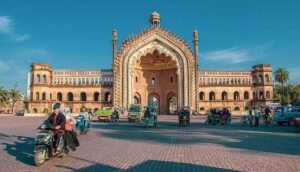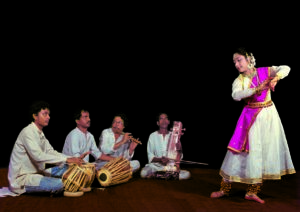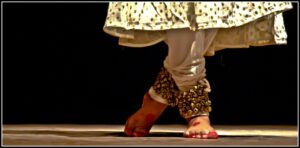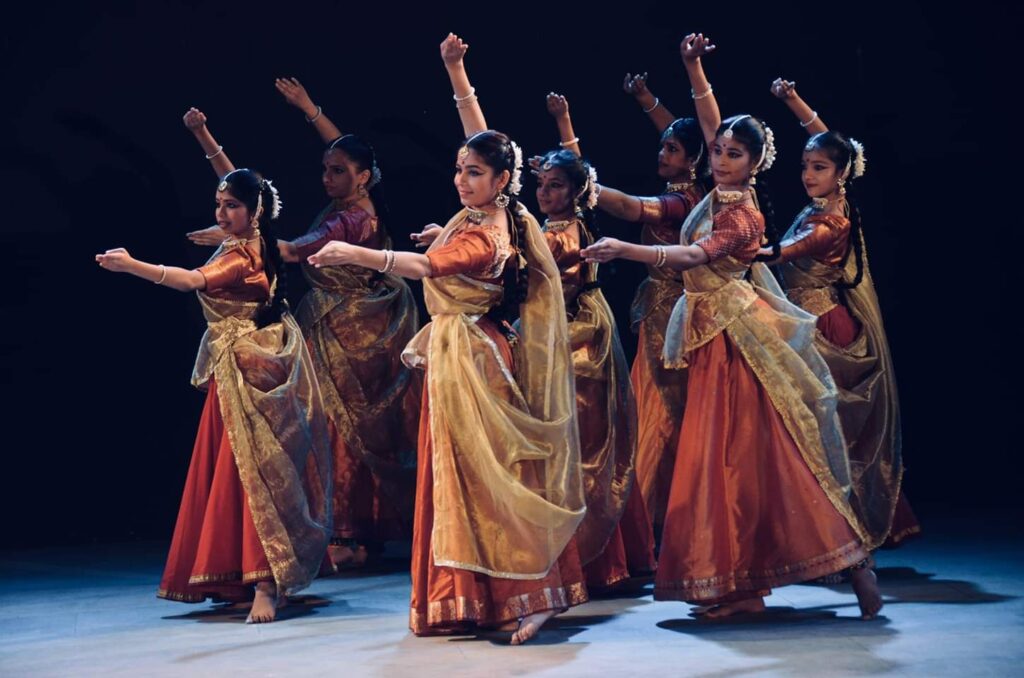Dancing Around India: Chapter 10 – Kathak
— by Srishti Bhattacharyya
–Reading Time – 14 min Approx
Lucknow was the one place that had Sunetra excited about something other than just the dance. After visiting the Dance School of Anamika, Sunetra had booked a flight to Lucknow the next day. The flight was supposed to leave Imphal at 3:30 PM and would take her to Lucknow at 8:10 PM after a small pause in Kolkata. Sunetra utilised her time in the flight to fill her journal about Manipur and Manipuri Raas Leela.
While entering the hotel, Sunetra had asked the receptionist if they would arrange a car for her the next day which the hotel management had agreed to do.
Sunetra had a pretty straightforward plan for the next day. Anamika had given her the number of one Kathak dancer in Lucknow and suggested she visit the Kathak Dance Class. Sunetra had taken the number of Mr. Dilip Shukla, the founder of this dance institution from Anamika and had called him. He was more than happy about talking to her. She was first going to visit the Kathak Dance Classes and then she would visit some of the tourist spots in Lucknow and have dinner before returning to the hotel.
That morning Sunetra woke up, had bread, butter and a cup of hot coffee for breakfast before she got into the car the hotel had arranged for her and headed to the Kathak Dance Classes.
Mr. Shukla was waiting for her outside the building. Sunetra greeted him with a wide smile.
“So what do you want to know?”
Sunetra shrugged her shoulders, “Everything. From the history to costumes, whatever you can tell me.”
Mr. Shukla laughed, “That’s a lot of information.”
“Do you mind if I record this conversation? I really wouldn’t want to piece anything.”
“Yeah, yeah, sure!”
“Okay,” Sunetra started the voice recorder in her phone, “Okay so you can start with the history if that’s okay.”
Mr. Shukla smiled and then began with the history of the Kathak dance form.
There are eight major forms of Indian Classical Dances, one of them is Kathak. The dance form originated in northern India but has a historical influence that is similar to that of Bharatnatyam, Odissi and other classical dance forms. It is, however, severely different from the folk dances that can be observed in the other parts of the country.
This performance Art has thrived as an oral tradition. It has innovated and taught people from one generation to the next only orally and through practice. It has transitioned, integrated and adapted the tastes of the Mughal courts, particularly by Akbar in the 16th and 17th Centuries. However, after the Mughal era, during the British Colonial period, it had seen a decline before it was born again after the independence of India.
The travelling bards of ancient Northern India, also known as ‘Kathakars’ or ‘storytellers’, are the ones who hold the title of being the originators of the Kathak Dance form. The word ‘Kathak’ has been derived from the Sanskrit word ‘Katha’, meaning story and ‘Kathakar’ meaning the one who tells the stories.
It has been noted by some scholars that Kathak dance in India can be traced back up to 400 BC. Just like all the other Indian Classical dance forms, the earliest text that has the roots of Kathak is the Natya Shastra which was endorsed by Sage Bharata. The complete compilation of the Natya Shastra can be dated to somewhere between 200 BCE and 200 CE. However, it has been found from estimations that the text can vary from 500 BCE to 500 CE.
According to the texts, the classical dance ‘Kathak’ began in the city of Varanasi and then migrated towards Lucknow and the other cities in North and North-West India. One Bhakti Movement devotee from the Handia village in Allahabad named Ishwari has attributed the style of the Kathak Dance developed in Lucknow. According to him, God Krishna had appeared in his dream and asked him to develop Kathak as a “form of worship”. Ishwari had then taught his descendants to preserve their learning through oral traditions. This went on for six generations after which it ultimately led to the current form of the Lucknow version of Kathak.
The development that the Kathak Dance form underwent during the time of the Bhakti Movement mostly revolved around stories of the God Krishna, his lover Radha, and the Gopis. There are also several stories, legends and texts such as the Bhagavata Purana that are found in the Vaishnavism Tradition. The love that was seen shared between Krishna and Radha was believed to be symbolic of the love between one’s soul and the Divine or the Cosmic Soul. This is one theme that is expressed by the Kathak Dancers.
Later on, the advent of Raslila in the Mathura in Western Uttar Pradesh is seen as a very important development. Raslila is a combination of narrative, music and dancing. The dance in Raslila was nothing but an extended version of the gestures and mimes that was made by the ancient Kathakars or storytellers. This had blended easily with the existing version of the traditional dance.
During the Mughal era, the dance form had started developing with a new incentive. There was a massive change when the dance which was initially only performed in temple courtyards was then moved to the palace ‘durbar’. A lot of necessary changes were also made in the presentation in both Hindu and Muslim palaces because of this. Kathak had become a highly stylized dance form and was then considered as an erudite form of noble entertainment that was provided to them by low-income families. The dances performed in the courts were always graceful, expressive as well as sensuous.
Kathak is considered a convergence of the Hindu and Muslim cultures. As said by Drid Williams, an important fact is that the first dancers to have danced in the Mughal courts were Hindus and the dances in the courts were not always religious since religious dances were not considered to be undesirable. Thus it is believed that the term ‘abstract’ dancing, dazzling turns, bell works and the transient, fleeting glimpse of Krishna and Radha were arising to remind the dancers about the reason for Kathak dance. Later on, more and more stories of Radha and Krishna made their way into the dances.
During the period when the British Colonialists had started making their way into India, Central Asian and Persian themes had also successfully wielded their way into the Kathak repertoire. Whirling like the Sufi dance and costumes that replaced the sarees had then become a part of the Kathak dance.
In the 19th Century, when the British Colonial rule had started taking over India, Kathak, like the other Indian classical dances was discouraged. This was a result of the Anglican missionaries who disparaged Hinduism as well as the Victorian morality of sexual repressiveness. An example of this is Reverend James Long who had suggested that the Kathak dancers should forget the tales regarding the Hindu legends and should replace them with the Christian tales and European legends. This frustration of the Christian missionaries is also recorded in the Church Missionary Review, it is said that they used to chant “Ram, Ram” after the Kathak performances.
At the beginning of the early 20th Century, a book named The Wrongs of Indian Womanhood spoke about the seductive facial expressions and gestures that we see in Kathak performances in family occasions or temples. According to the book, these expressions and gestures were evidence of “slavery to idols”, “harlots” and “debased erotic culture”. The Christian missionaries had demanded that this has to stop. They had launched some anti-dance movement in 1892. The newspapers and print media had dehumanised the Kathak dancers. The dance was even accused to be a fake front for prostitution.
Not only were the British colonial officers and Christian missionaries ridiculing the Kathak dancers, but also the Indians who were educated in British Institutions had joined in. The ridicule was focused much more on the female Kathak dancers, who were referred to as the ‘nautch girls’. The Hindu families had during this time continued teaching Kathak to the students in private. They had also shifted to teaching boys the dance and keeping the art live through the oral tradition since the ridicule was mostly targeted towards the girls.
After the end of the Colonial rule and the beginning of an independent India, Kathak was once again revived, this time, more broadly. It was an effort to rediscover history and reclaim the lost culture. The movements to revive Kathak had arisen from both the Hindu and Muslim Gharanas or Schools, mostly by the community called Katha-Misra. However, the sub-traditions of Kathak based in Jaipur and Lucknow have gained the most scholarship.
In 1956, the oldest Kathak Department was formed in the Indira Gandhi Kala Sangeet University. It was a public university in Khairagarh where Dr. Puru Dadheech had first set the syllabus for the degree program of Kathak.
“That is a lot of information,” Sunetra said out loud in wonder, making Mr. Shukla smile.
“Kathak, like all the other Indian classical dances has a very rich history. A lot of people show interest in learning the dance but not many of them show much interest in the history and how it came to be what it is today.”
Sunetra nodded.
“Anyway, let’s continue.” Mr. Shukla continued.
The modern Kathak dance has three main sections – the invocation, the pure and abstract dance recital and the expressive dance.
The invocation is the part where the dancers come to the stage and offer their respect to their teachers, gurus and the other musicians on the stage. If the dance is based on the Hindu tradition then the dancer has to combine hand gestures (mudras) as well as facial expressions to invoke the Gods and Goddesses. When the dance is based on the Muslim tradition then instead of an invocation, the dancers offer a ‘salami’ or salutation. The facial expressions and the gestures convey the emotional taste and sentiments as well as the mood of the underlying story or the ‘bhava’.
The costumes that are used in Kathak performances often vary but are always almost inspired by the Hindu and Muslim Cultures.
The costume based on the Hindu culture has two variations for the females. One of them is a Saree but is worn in a way that is different from the traditional customary style. When a Kathak performer wears a Saree for her performance, she has to wrap the Saree around the waist and hang the excess cloth from the left. A ‘choli’, or a blouse, is used to cover the upper body. A scarf or ‘orni’ is also often used. The hair, face, neck, ear, wrist, hand, ankle are all adorned with jewellery which is typically of gold, and she has a ‘bindi’ or ‘tika’ in the middle of her forehead.
In the second variation of the costume, the girl wears a light-weighted, long skirt that reaches just above the ankle and is embroidered on the borders to help enhance the motion of the dance. The choli, in this case, is of a contrasting colour and the scarf which is transparent is draped over the dancer’s head. Jewellery is usually the same as the first variation.
The Muslim culture influenced costume for the females has a skirt, a close-fitting ‘Churidar Pyjamas’ and sometimes, a long coat that covers the upper body and hands of the dancer. The dancers with this costume have a scarf covering their heads and the jewellery is very light.
For the male dancers, the Hindu variation of the cloth included draping a silk ‘dhoti’ around the waist with a silk scarf tied over the top of it. The upper body is usually left bare except for the Hindu thread called ‘poite’. But sometimes there is a loose sleeveless jacket to cover the upper body. The jewellery for the male dancers is often much simpler than the female dancers and is only made of stones.
The collection of musical instruments used for a performance of Kathak can vary based on the performer. The number of instruments used usually ranges from between two or twelve instruments. The musical instruments that are most commonly used in Kathak are the table (hand drums) that are played in sync with the rhythm of the dancers’ feet, Harmonium with Manjira (hand Cymbals) that is used to measure the cycles. Other instruments are used to ad effect, structure and depth to the performance.
India’s senior Kathak exponent, Dr. Pandit Puru Dadheech had for the first time introduced Dhrupad, the ancient music genre of India, to Kathak. He is the first Kathak dancer of India to have brought back Dhrupad to the formal stage of Kathak and introduced the composition in 28 mantras. The Dhrupad of Shankar Pralayankar has the unique status of being sung in concerts quite often by the Dhrupad maestros, the Gundecha Brothers.
There are three Gharanas or Schools of Kathak dance that are the most known. These are situated at Jaipur, Lucknow and Benares. These three major schools put emphasis on different aspects of the dance, like acting, footwork, et cetera.
The origin of the Jaipur Gharana can be traced back to the time of Bhanuji, a Shiva Tandava dancer. The Kathak dance developed in the Jaipur Gharana, or the Jaipur style Kathak, had developed under the control of the Rajput rulers and the themes of this dance favour the religious themes of Hinduism. In modern times, the school puts emphasis on dance and footwork. The dancers here include Jai Lal, Kundan Lal, Janki Prasad, Nawal Kishore and Mohan Lal. The school is famous for the ability to express a story beautifully through dance and for the methodical innovations in rhythmic dancing.
The origin of the Lucknow Dance Gharana goes back to the time of a devotee of Krishna named Ishwari. He aimed to develop Kathak as a form of loving and worshipping Krishna. In modern times, the dance of the Lucknow Gharana influences the schools of dance n Delhi with Birju Maharaj, Lacchu Maharaj and Shambu Maharaj. The Lucknow style Kathak has developed a lot of themes other than that of Radha and Krishna. It has now spread over to the dramas of Shiva-Parvati by Kalidasa and Malati-Madhav by Bhavabhuti.
The Benaras Gharana or Benaras style of Kathak is believed to be the oldest one. The history of the school is unclear but it is believed that the school has started in Varanasi by a man from Bikaner named Janakiprasad. He was a Sanskrit scholar and a dancer whose ancestors were also famed musicians and dancers. Janakiprasad is also believed to have invented the ‘bols’ of Kathak, i.e. mnemonic syllables related to the language of this classical dance of India.
“How has Kathak influenced the other Indian dances or performance art traditions?”
“Oh, there is a lot!” Mr. Shukla said and started another part of the story.
Even if the root of both the dances is the Hindu Text, Natya Shastra, the North Indian dance style Kathak differs a lot from the South Indian dance style, Bharatnatyam. The expressions in Kathak dance are more withdrawn and introverted while those of Bharatnatyam are more expansive and extroverted. Moreover, Kathak is a dance which is performed in a stance where the knees and the torso is straight whereas Bharatnatyam is a dance which is performed in a half-sitting position with bent knees.
Even though both the dance forms follow the tradition of ‘story play’ and tell stories from the Hindu Puranas and Epics, there are also a few notable differences between Kathak and Kathakali. Kathak has a relatively modern origin that Kathakali, it follows the Hastha Lakshanadeepika text of the 16th Century. Both the dances have different dance language and music but are performed along with a similar kind of traditional musical instruments.
However, it has been said that Kathak has a few rhythmic, visual and kinaesthetic similarities with the dance form called Spanish Flamenco.
Kathak had also influenced some of the regional performance art forms. An example of this is Bhavai, a form of traditional theatre that focuses on telling the stories of Hindu Goddess Shakti. It had originated in the medieval era and now can be found in Rajasthan, Gujarat, and Madhya Pradesh. Another example of regional performance art influenced by Kathak is Thumri. This was developed by the tawaif community, referred to as ‘Nautch’ by the British.
“The dances really came a long way. it really is a shame that people don’t show enough enthusiasm to learn about the history.”
“Well, it is a good thing that there are still people like you who are interested enough to bring these little pieces of information to the people.”Sunetra smiled.
After a little more chit chat Sunetra asked Mr. Shukla if she could see a training session before she left, to which the owner immediately agreed.
While standing at one side and watching the students try to take the perfect stance, Sunetra wondered how her life would be if the accident hadn’t occurred. But then she stopped her line of thoughts and focused on the present.
She might not have gotten to perform as much as she wanted, but she was still doing something that she loved and that was enough for her.


